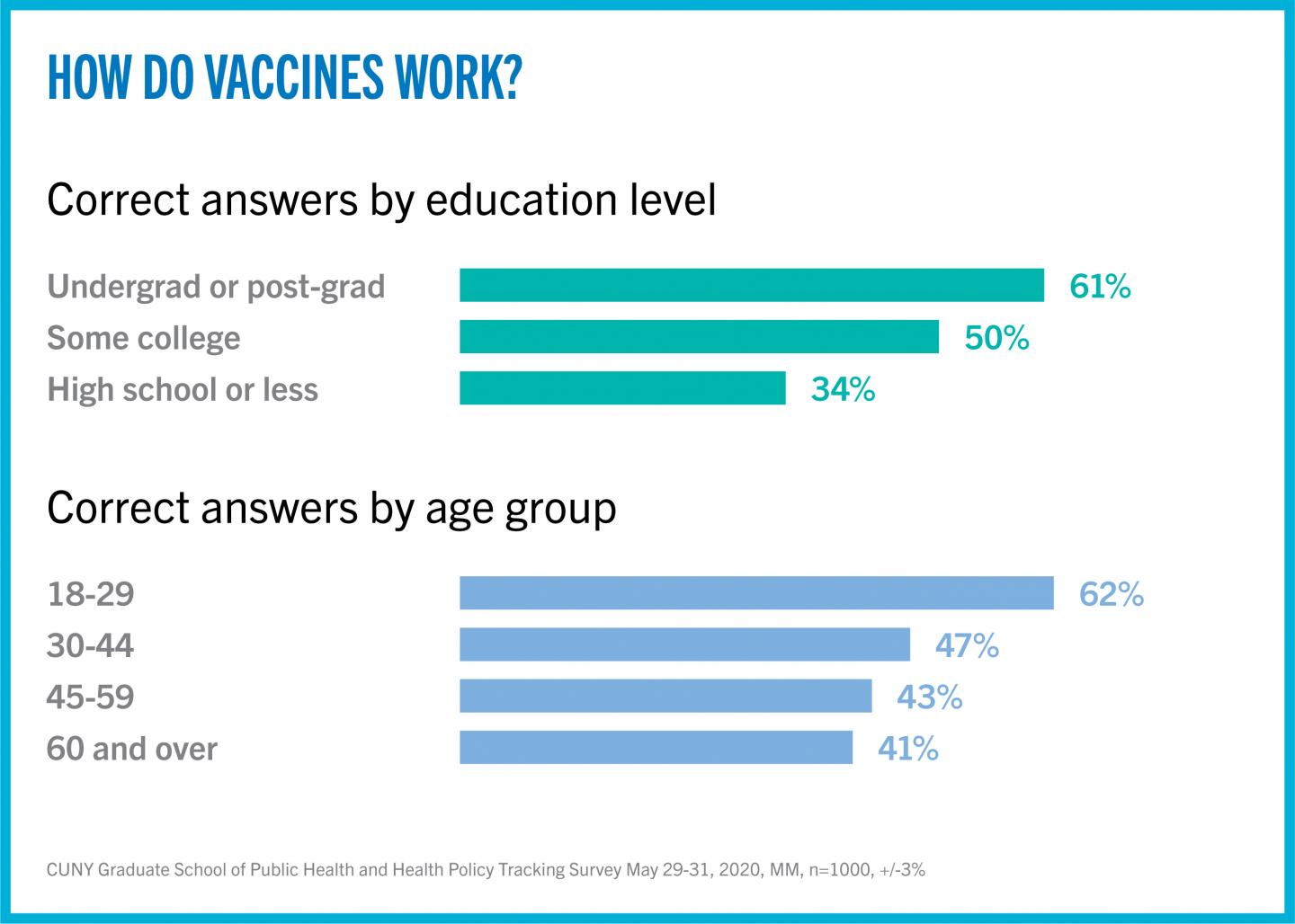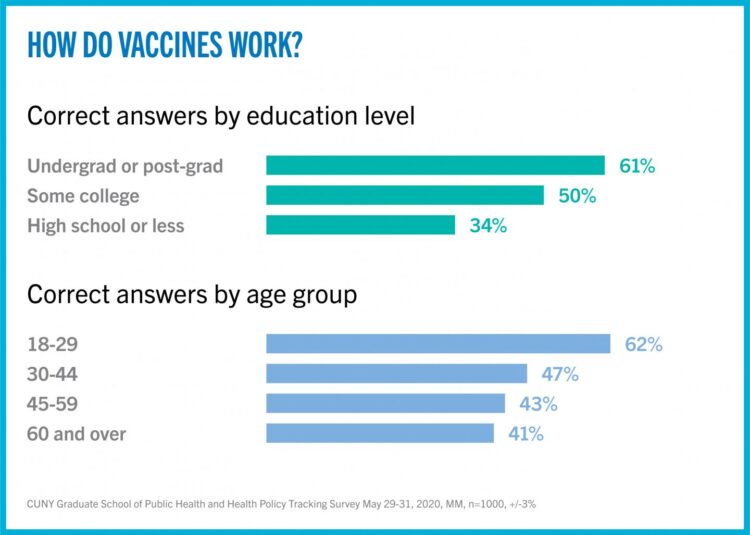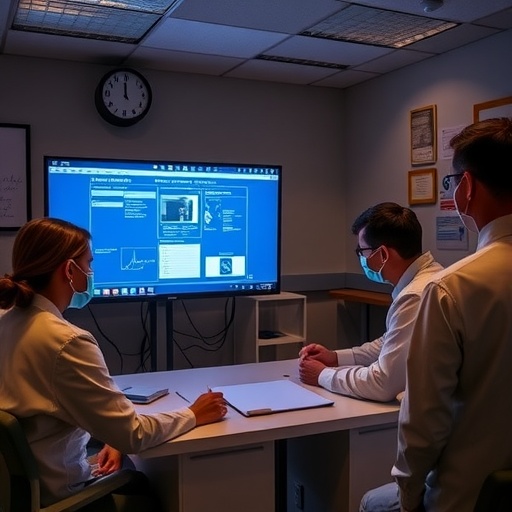Lack of knowledge may stop many New Yorkers from taking a COVOD-19 vaccine, but personal experience of disease may encourage them

Credit: CUNY Graduate School of Public Health & Health Policy
Slightly less than half (48%) of New Yorkers know how vaccines actually work, but those who do are about 7% more likely to say they will take a COVID-19 vaccine when one becomes available. Knowledge apart, however, 81% of those New Yorkers who have seen the symptoms of COVID-19 in their own households say they are likely to accept a vaccine.
These are key findings from responses to questions about coronavirus infection and vaccines that could prevent it that were asked in the tenth city and statewide tracking survey from the CUNY Graduate School Health Policy (CUNY SPH), conducted May 29-31.
“A public health survey is not supposed to be a classroom test,” said Dr Ayman El-Mohandes, Dean of CUNY SPH. “Survey researchers usually ask only what people have experienced and what they think. We added a vaccine knowledge question to our latest survey because we believe that if people understand what vaccines are, how they work and what they do, they may be more likely to accept them,”
Respondents were asked, “Of the following statements, which describes most accurately how vaccines work?” Four options were given, including a standard definition of how a vaccine works, which states that, “Vaccines prepare your immune system to recognize and disarm harmful viruses and bacteria.”
When asked whether or not they plan to take a coronavirus vaccine, a substantial number of New Yorkers (74%) said they do. Accurate knowledge of how vaccines work seems to increase the likelihood of accepting a vaccine: those who chose the correct statement describing how vaccines work were about 7% more likely to accept the vaccine when it becomes available.
“These numbers are encouraging. But when a 70% immunization rate is the absolute minimum that public health experts believe will be required to protect a community against the coronavirus, even a small gap in public understanding is troubling. Nor would one wish direct experience of this terrible disease to be the best teacher of the need for a vaccine”, Dr. El-Mohandes explained.
Who Knows How Vaccines Work and Who Doesn’t?
Some subgroups were more likely to know how a vaccine works than others.
The correlation between a respondent’s age and a correct answer was striking. More than 3 in 5 (62%) of New Yorkers aged 18-29 chose the right definition. The percentage of correct answers dropped under half among older respondents. Among people aged 30-44, 47% answered correctly; 45-59, 43% answered correctly, a figure that dropped to 41% among respondents aged 60 or older.
Women (51%) were more likely to know how vaccines worked than men (45%).
Education correlated predictably with knowing how a vaccine works. While almost 5 in 8 (61%) of respondents with an undergraduate or postgraduate degree answered correctly, the percentages dropped to 50% among those reporting some college and 34% for those with a high school degree or less.
Race and ethnicity were also factors. Nearly three in five (56%) of respondents identifying themselves as White knew how a vaccine worked, compared to 49% of Asians, 42% of African-Americans and 42% of LatinX/Hispanic respondents.
“This is important information, as it will help public health communicators begin to frame precisely-worded educational messages and choose audience-specific communication media to improve the climate of acceptance for a future COVID-19 vaccine,” explained Dr. Scott Ratzan, Distinguished Lecturer at CUNY SPH.
Do vaccine opponents or conspiracy theorists present an obstacle?
All survey respondents were asked to what degree they opposed or accepted the idea of vaccination generally. Here the distribution clearly favored vaccine acceptance: Only 3% of respondents said they were totally opposed to vaccinations, while 16% identified themselves as hesitant to vaccinate. About a quarter (26%) of respondents said they would decide based on credible information and a similar number said they would follow their doctor’s advice. More than three respondents in ten (31%) described themselves as vaccine believers.
In general, however, New Yorkers from all audience segments have grown extremely suspicious of the entire environment surrounding COVID-19. Almost two-thirds (65%) believe that “the spread of the COVID-19 pandemic or the response to it are influenced by the private influence of powerful but hidden groups” is definitely or probably true. Notably, of those who got the vaccine question right, 57% believe this, and 43% do not. That is not terrific, but it is quite a bit better than among those who got the vaccine definition question wrong: 72% believe in the conspiracy and 28% do not.
“These findings suggest that public health leaders face unusual added challenges in persuading the public to continue to modify their daily lives as well as to accept a coronavirus vaccine, when one becomes available,” Dr. Ratzan stated.
Can potential vaccine refusers’ minds be changed?
The 27% of all survey respondents who said they would not be likely to take a new coronavirus vaccine were asked which factors might induce them to change their minds about immunizations.
Expense does not appear to be a major factor. About four in ten (39%) say cost would be a factor in their refusal. A similar proportion (36%) said they would consider the vaccine if it were given free.
Completely convincing evidence of a coronavirus vaccine’s safety (77%) and efficacy (75%) could change these respondents’ minds, however.
Credibility of the source of this evidence could prove elusive, however. Just 42% of these likely vaccine refusers would be swayed by approval of a coronavirus vaccine from the FDA or CDC.
“This last finding genuinely startled me,” said Dr. Kenneth Rabin, Senior Scholar at CUNY SPH. “I have spent the last 40 years in health communication and for that entire time the FDA and CDC have been almost universally regarded by doctors, consumers and the news media as the gold standards of information about the safety and efficacy of vaccines, and of people’s need for them.”
The complete survey results and related commentary can be found at https:/
Survey methodology:
The CUNY Graduate School of Public Health and Health Policy (CUNY SPH) survey was conducted by Emerson College Polling from May 29-31 (week 12). This tracking effort started March 13-15 (week 1), and continued with questions fielded March 20-22 (week 2) and March 27-29 (week 3), April 3-5, 2020 (week 4), April 10-12, 2020 (week 5), April 17-29 (week 6), April 24-26, 2020 (week 7), May 1-3, 2020 (week 8), and May 15-17, 2020 (week 10).
The sample for the NY Statewide and New York City results were both, n=1,000, with a Credibility Interval (CI) similar to a poll’s margin of error (MOE) of +/- 3 percentage points. The data sets were weighted by gender, age, ethnicity, education and region based on the 2018 1-year American Community Survey model. It is important to remember that subsets based on gender, age, ethnicity and region carry with them higher margins of error, as the sample size is reduced. In the New York City results, data was collected using an Interactive Voice Response (IVR) system of landlines (n=475), SMS-to-online (n=327) and an online panel provided by MTurk and Survey Monkey (n=197). In the Statewide results, data was collected using an Interactive Voice Response (IVR) system of landlines (n=469), SMS-to-online (n=319) and an online panel provided by MTurk and Survey Monkey (n=212).
The CUNY Graduate School of Public Health and Health Policy (CUNY SPH) is committed to teaching, research, and service that creates a healthier New York City and helps promote equitable, efficient, and evidence-based solutions to pressing health problems facing cities around the world.
###
Media Contact
Barbara
[email protected]
Original Source
https:/





